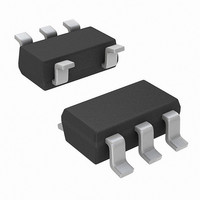LM27CIM5-ZHJ/NOPB National Semiconductor, LM27CIM5-ZHJ/NOPB Datasheet - Page 6

LM27CIM5-ZHJ/NOPB
Manufacturer Part Number
LM27CIM5-ZHJ/NOPB
Description
IC TEMP SENS SGL 120DEG SOT23-5
Manufacturer
National Semiconductor
Series
PowerWise®r
Datasheet
1.LM27CIM5X-ZHJNOPB.pdf
(10 pages)
Specifications of LM27CIM5-ZHJ/NOPB
Sensing Temperature
120°C Trip Point
Output Type
Active Low/Open Drain
Voltage - Supply
2.7 V ~ 5.5 V
Accuracy
±3°C
Package / Case
SC-74A, SOT-753
Lead Free Status / RoHS Status
Lead free / RoHS Compliant
Other names
LM27CIM5-ZHJ
LM27CIM5-ZHJTR
LM27CIM5-ZHJTR
www.national.com
Applications Hints
NOISE CONSIDERATIONS
The LM27 has excellent power supply noise rejection. Listed
below is a variety of signals used to test the LM27 power
supply rejection. False triggering of the output was not ob-
served when these signals where coupled into the V+ pin of
the LM27.
Testing was done while maintaining the temperature of the
LM27 one degree centigrade way from the trip point with the
output not activated.
MOUNTING CONSIDERATIONS
The LM27 can be applied easily in the same way as other
integrated-circuit temperature sensors. It can be glued or
cemented to a surface. The temperature that the LM27 is
sensing will be within about +0.06˚C of the surface tempera-
ture to which the LM27’s leads are attached to.
• square wave 400kHz, 1Vp-p
• square wave 2kHz, 200mVp-p
• sine wave 100Hz to 1MHz, 200mVp-p
FIGURE 2. Resistor placement for capacitive loading
TABLE 1. Resistive compensation for capacitive
≤100pF
C
100nF
10nF
≥1µF
1nF
b) R in series with signal path
LOAD
a) R in series with capacitor
compensation of V
loading of V
(Continued)
TEMP
TEMP
R (Ω)
8200
3000
1000
430
0
20030717
20030718
6
This presumes that the ambient air temperature is almost the
same as the surface temperature; if the air temperature were
much higher or lower than the surface temperature, the
actual temperature measured would be at an intermediate
temperature between the surface temperature and the air
temperature.
To ensure good thermal conductivity, the backside of the
LM27 die is directly attached to the GND pin (pin 2). The
temperatures of the lands and traces to the other leads of the
LM27 will also affect the temperature that is being sensed.
Alternatively, the LM27 can be mounted inside a sealed-end
metal tube, and can then be dipped into a bath or screwed
into a threaded hole in a tank. As with any IC, the LM27 and
accompanying wiring and circuits must be kept insulated and
dry, to avoid leakage and corrosion. This is especially true if
the circuit may operate at cold temperatures where conden-
sation can occur. Printed-circuit coatings and varnishes such
as Humiseal and epoxy paints or dips are often used to
ensure that moisture cannot corrode the LM27 or its connec-
tions.
The junction to ambient thermal resistance (θ
rameter used to calculate the rise of a part’s junction tem-
perature due to its power dissipation. For the LM27 the
equation used to calculate the rise in the die junction tem-
perature is as follows:
where T
voltage, I
current on the V
output, and I
the LM27’s junction temperature is the actual temperature
being measured, care should be taken to minimize the load
current that the LM27 is required to drive.
The tables shown in Figure 3 summarize the thermal resis-
tance for different conditions and the rise in die temperature
of the LM27 without any loading on V
resistor on an open-drain digital output with a 5.5V power
supply.
FIGURE 3. Thermal resistance (θ
Still Air
Moving Air
A
is the ambient temperature, V
Q
DO
is the quiescent current, I
rise due to self heating (T
is the load current on the digital output. Since
TEMP
(˚C/W)
TBD
250
θ
no heat sink
JA
SOT23-5
output, V
T
TBD
0.11
(˚C)
J
−T
DO
A
is the voltage on the digital
JA
TEMP
(˚C/W)
+
) and temperature
small heat sink
TBD
TBD
L_TEMP
θ
is the power supply
J
JA
−T
and a 10k pull-up
SOT23-5
A
)
JA
is the load
) is the pa-
T
TBD
TBD
(˚C)
J
−T
A
(3)










